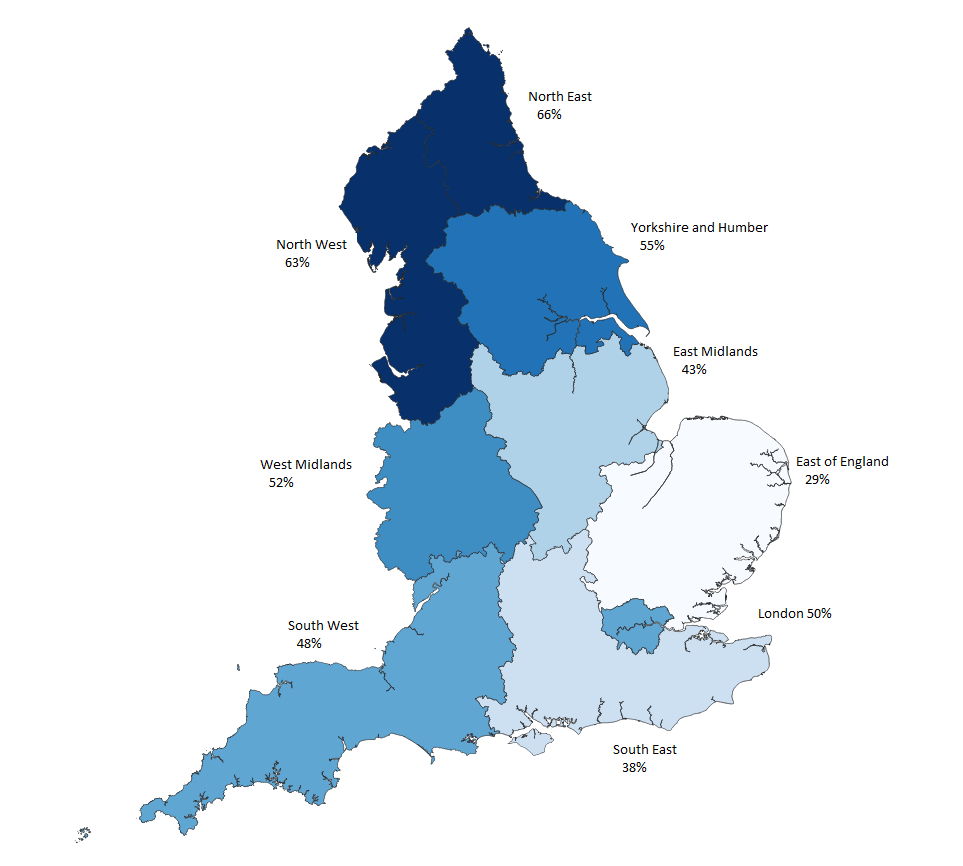In our latest Ask the Expert event, kindly sponsored by the ESRC, a part of UK Research and Innovation, Professor Michael Donnelly, Senior Lecturer at the University of Bath, shared his research findings looking at university admissions through a geographic lens, and what they reveal about social mobility.
Professor Donnelly noted that the debate surrounding the role of social mobility in university admissions has failed to incorporate the aspect of geography. He has undertaken research which explores the geographical patterns in movements of students across different dimensions and contributes to the broader debate surrounding the roles of social class and ethnicity in higher education admissions.
Overall, the split between students who are geographically mobile (moving away from their home region for university) and those who stay in their home region is roughly split 50/50. That is to say, roughly half of students move to another part of the UK for university and half do not.
However, digging into this split, there are certain interesting trends. Those belonging to higher socio-economic groups were very regionally mobile, at 62%, not far off from privately educated students, of whom 75% were regionally mobile. In comparison, just 45% of students in higher education who went to a state school moved away for university.
Split by ethnicity, the least geographically mobile students were those from Pakistani backgrounds (20% of whom moved) and Bangladeshi backgrounds (30%).
Controlling for all these characteristics (and others), Professor Donnelly’s research reveals that the largest determinant for geographical mobility was the home region of the student.
Figure 1 below, shows the proportion of English students staying in their home region for university. Prospective students in the East of England are most likely to fly the nest, with only 29% remaining in the region for higher education. By stark contrast, the greatest proportions of students staying in their home region are from northern regions. Two thirds of students in the North East do not move away for university.
Figure 1: Proportion of students attending university in their home region in England, 2014-15 cohort

Source: Donnelly, M. and Gamsu, S. (2018) Regional structures of feeling? A spatially and socially differentiated analysis of UK student im/mobility, British Journal of Sociology of Education
A separate strand of Professor Donnelly’s research indicates that students from the highest socio-economic groups are much more likely to move longer distances; similarly, those from the lowest socio-economic groups are more likely to stay at home and commute to university. Disparities in ethnicity layer on top of this finding: white and Chinese students are the most likely to move long distances, whereas Pakistani and Bangladeshi students are the most likely to stay at home and commute.
The best universities for attracting long distance movers are the University of Falmouth (65% of students) and Durham University (61%). Attracting students from further away doubtlessly illustrates the wide-reaching appeal of such institutions. However, further questions arise surrounding the commitment of universities to the economic development of the region in which they are located. This is particularly troubling for Durham University as the North East is the region with the smallest proportion of geographically mobile students.
Perhaps the more novel dimension to Professor Donnelly’s research is the qualitative work he undertook with students before they left for university. This consisted of two aspects: students were asked to colour in a map of the UK, assigning certain colours to regions they would prefer to live in more, and others for regions they would rather like to avoid. Face-to-face interviews followed. This provided for a rich discussion and insights into decision-making.
The map-colouring exercise revealed the perceptions of young people towards the different nations and regions of the UK. London schoolchildren, for instance, have a more positive impression of Edinburgh as a big, vibrant city, compared to cities in Wales. Whilst Wales is geographically closer, Edinburgh is perceived as more similar to their ideal living environment. If aspiring students prefer to move to the type of places they grew up in, this will doubtless have consequences for social mobility.
For many, some of the obstacles to being more geographically mobile were unsurprising, if unfortunate: the cost of travelling to far-away places for students in the North, for instance. Cash-strapped schools are unlikely to be able to afford day trips to universities which only some students may ultimately attend. By contrast, schools in London seemed to facea different scenario: universities and graduate employers are banging on the door to get in and speak to would-be students.
This exposes a tension at the heart of widening participation policy: the hunt for a more diverse intake (by socio-economic status or ethnicity) does not extend to geographical diversity. Able students in the north just do not seem to be getting the same attention as their peers in the south.
There are two broad conclusions which can be drawn from Professor Donnelly’s research. The first is that the choice of which university to attend is clearly not limited to simple metrics such as university league table rankings. Location plays an undeniable role, often reflecting socio-economic and ethnic inequalities.
The second conclusion is that widening participation activities are fraught with inherent contradictions. If we want the best students to attend the best universities then, if they choose not to return home, this represents ‘brain drains’ for their home regions. If, on the other hand, students stay in their home region for university, they may be forgoing opportunities for social mobility which will be taken up by more affluent peers from the rest of the country. Universities should pay closer attention to the geographical aspect of their intakes. However, universities also need to strike a balance between picking the most able students and their commitment to their regional labour market.
